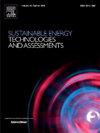New energy products going global: The impact of digital transformation amid trade frictions
IF 7.1
2区 工程技术
Q1 ENERGY & FUELS
Sustainable Energy Technologies and Assessments
Pub Date : 2024-09-26
DOI:10.1016/j.seta.2024.104009
引用次数: 0
Abstract
New energy industry is the key field in which China has suffered from trade frictions. It remains to be explored whether digital transformation can enhance export resilience and alleviate the negative shock of trade frictions. Based on the export data of new energy products, this paper uses a panel two-way fixed effects model to explores whether digital transformation can alleviate the negative shock of trade frictions on the exports of new energy products. We find that (1) trade frictions lead to an average decrease of 11.45% in the export value of new energy enterprises and an average increase of 0.84% in the probability of exiting the export market. (2) Digital transformation can buffer the negative shock of trade frictions. For enterprises undergoing digital transformation, the negative shock of trade frictions on exports are relatively limited. (3) Mechanism test indicates that digital transformation accelerates the export products conversion and export markets transfer, thereby alleviating the negative shock of trade frictions. From the digital transformation perspective, this paper provides targeted policy implications for enhancing the export resilience of new energy enterprises and forming a sustained buffering mechanism to alleviate trade friction shocks.
新能源产品走向世界:贸易摩擦中数字化转型的影响
新能源产业是中国遭遇贸易摩擦的重点领域。数字化转型能否增强出口韧性,缓解贸易摩擦的负面冲击,仍有待探索。本文基于新能源产品的出口数据,采用面板双向固定效应模型,探讨数字化转型能否缓解贸易摩擦对新能源产品出口的负面冲击。我们发现:(1)贸易摩擦导致新能源企业出口额平均下降 11.45%,退出出口市场的概率平均上升 0.84%。(2)数字化转型可以缓冲贸易摩擦的负面冲击。对于进行数字化转型的企业而言,贸易摩擦对出口的负面冲击相对有限。(3)机制检验表明,数字化转型加速了出口产品转换和出口市场转移,从而缓解了贸易摩擦的负面冲击。本文从数字化转型的角度,为增强新能源企业出口韧性,形成持续缓冲机制,缓解贸易摩擦冲击提供了有针对性的政策启示。
本文章由计算机程序翻译,如有差异,请以英文原文为准。
求助全文
约1分钟内获得全文
求助全文
来源期刊

Sustainable Energy Technologies and Assessments
Energy-Renewable Energy, Sustainability and the Environment
CiteScore
12.70
自引率
12.50%
发文量
1091
期刊介绍:
Encouraging a transition to a sustainable energy future is imperative for our world. Technologies that enable this shift in various sectors like transportation, heating, and power systems are of utmost importance. Sustainable Energy Technologies and Assessments welcomes papers focusing on a range of aspects and levels of technological advancements in energy generation and utilization. The aim is to reduce the negative environmental impact associated with energy production and consumption, spanning from laboratory experiments to real-world applications in the commercial sector.
 求助内容:
求助内容: 应助结果提醒方式:
应助结果提醒方式:


